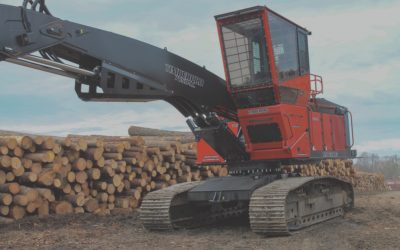Oregon Loggers Working To Find, Develop New Employees
Article by Dan Shell, Managing Editor, Timber Harvesting March/April 2022
 EUGENE, Oregon
EUGENE, Oregon
Throughout three days of the Oregon Logging Conference (OLC), the effort to reach young people and find new employees from all walks of life was a focus of the show. Of course, everyone loves to prop the little kids in an operator’s cab, but the OLC has refined their show’s outreach to focus primarily on high-school aged students who are soon to be making decisions on work and career choices.
More than 900 local and regional high schoolers were registered to visit the OLC, which included presentations tailored to school groups about job opportunities. Students were able to talk with forest industry professionals working in forestry, reforestation, logging, trucking, engine mechanics and welding, machine operators and more— with almost all currently looking for new employees.
Known as “Future Forestry Workers Career Day,” the event this year included a cut-to-length simulator competition sponsored by Oregon State University’s College of Forestry using John Deere simulators. Ponsse also had a simulator at its booth that was a hit with students.
State educators also have a big role to play, according to OLC keynote speaker Blake Manley, a former logger and forestry and natural resources teacher at Sweet Home High School—and also Chair of the Oregon Natural Resources Educators Assn. He’s a relentless forestry career promoter.
One thing Oregon does have going for it is a state-approved high school forestry curriculum that’s currently being offered by 35 school systems in the state. Manley told hundreds of loggers assembled for the keynote that the four legs of support for developing high school forestry interest are: 1— having a state-approved curriculum; 2—having administrative support at the school; 3—finding the right teacher (and it’s not always the guy with the flannel shirts); and 4—building local and industry support for the program.
Manley noted all communities are different and may choose to emphasize various segments of forestry, “But you all have the potential to have these programs in your schools,” he emphasized. “If you want to know how, find me.”
Associated Oregon Loggers is also working to find new employees for its members and help them keep the ones they have. Recently hired AOL Workforce Development Manager Sara Nelson notes in an AOL Mainline newsletter article that on a recent survey an aging workforce, lack of forest career promotion and demand for higher wages were major labor issues for AOL members.
Changing the forest industry narrative to make it more enticing to young people is a major goal, she says. Also, surveys show AOL members rely heavily on word of mouth when looking for employees. Industry may be able to do better by getting its message consistently in front of groups that are actively seeking jobs. AOL has also printed out some nifty forest career “playing cards” to hand out to interested individuals, with a QR code that links to the AOL web site.
FOREST ACCORD
Oregon’s Private Forest Accord (see Newslines) seeks to move beyond attempting to manage forests by expensive and potentially calamitous ballot initiative campaigns, but it also moves the state into a brave new world of enhanced riparian zone and stream protection in return for certainty of future harvests.
As with any such far-reaching effort hammered into legislation, the devil is in the details.
Associated Oregon Loggers formally voted to support the accord that was negotiated by major landowners and industry interests with state and environmental interests during the past two years. But loggers at the OLC are in waiting mode for the accord’s ultimate impact.
One logger noted his family’s timber holdings would qualify for mitigation funding under the accord. He’s happy to hear he’ll be compensated but he’s definitely reserving final judgement until the details are ironed out.
Another logger said he hoped the stream-side protections would be results- based instead of prescriptive based where protection guidelines would be adequate and work as intended but not consist of blindly followed mandates.
Others noted that major landowners going forward will likely reduce private forest timber rotations, with more loggers having to handle more small logs in the future.
Latest News
Weyco Buys Land From Roseburg In North Carolina
Weyco Buys Land From Roseburg In North Carolina Weyerhaeuser Co. is acquiring 117,000 acres of high-quality timberlands in North Carolina and Virginia from Roanoke Timberlands LLC, a subsidiary of...
New From Komatsu: TimberPro Swing Machine
New From Komatsu: TimberPro Swing Machine A durable, powerful and productive machine designed to move mass quantities of large timber in yard environments, the TimberPro TB785D swing machine is...
WANT MORE CONTENT?
Spanning seven decades since its inception in 1952, Timber Harvesting highlights innovative and successful logging operations across the U.S. and around the world. Timber Harvesting also emphasizes new technology and provides the best marketing vehicle for the industry’s suppliers to reach the largest number of loggers in North America and beyond.
Call Us: 800.669.5613

